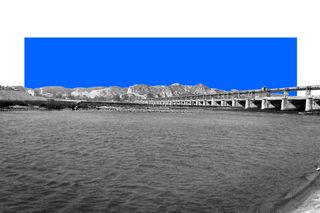
How Inter‑State River Disputes Undermine Our Relationship With Water as a Shared Resource
The Supreme Court this week intervened in a number of disputes — all of which undermine the idea of water as shared commons.

The Supreme Court on Tuesday presided over two separate inter-state river disputes, asking the union to intervene to find amicable solutions to neighboring states’ water conflicts, reported LiveLaw. It noted in one of the judgments that “Water is a natural resource and living beings must learn to share it, whether it is individual(s) or states. The matter cannot be looked at from the point of view of only one state.”
The Indian terrain is riddled with both inter-state as well as international river-water disputes. In 1956, the Indian Government brought into force the Inter-state River Water Disputes Act to resolve disputes arising from sharing river waters between different states. Internationally, India has signed the Indus Water Treaty with Pakistan and the Ganges Water Sharing Treaty with Bangladesh to address disputes arising from utilizing the water of these transnational rivers. But what the treaties have in common is the fact that they all territorialize water — which has troubling implications.
The act and the treaties identify the many ways in which disputes may occur between upstream and downstream locations. A downstream state building a dam, for instance, may cause floods and draughts in the upstream state, and vice versa. Other reasons behind disputes may be an upstream state’s various agricultural or industrial activities that rely on using up the water from the river or diverting its natural course, all of which could hinder the water supply necessary for the downstream state’s nourishment and development. The act and the treaties are, however, framed from a development point of view, where the state’s sovereignty is the chief stakeholder. This undermines the value of the river as a shared commons.
Cultural or natural resources that are available to all members of a society, in environmental parlance, are called the commons. These resources are meant for equitable access and are to be respected, not claimed for the use or benefit of just one individual or organization. Since these resources are shared between all members of a society, it becomes the shared responsibility of each member to also protect these them from destruction.
Environmental activists and indigenous communities argue that community forests, rivers and wetlands, and pastoral land and grasslands, must qualify as commons universally, to not only protect them from destruction in the name of development but also to protect the lives and cultures of the people who reside around them. Historically, areas have been designated as commons to stop further depletion of resources and livelihoods from those areas. But when state governments draw borders on waterbodies like rivers, they compromise the value of the commons and even perpetuate unequal access to them.
Related on The Swaddle:
To Keep Our Coastal Cities From Drowning in Floods, We Have to Reimagine Land Use
In India, the river has always been an integral part of a state’s industrial ambitions. Large dams that came up in the period following Independence were celebrated as temples of modern India‘s development story. 75 years after Independence, the state continues to approve and endorse new mega-dam projects, emphasizing that they are necessary to meet a burgeoning population’s increasing consumption and energy needs. States that are keen on building dams may also divert water from the river’s natural pathway to take care of consumption and irrigation needs, and thus affect the river’s water quality by engaging in deforestation around the river.
These development projects by the center and the states ignore the massive deaths and displacements caused, largely to indigenous communities that build their culture around these rivers and other commons. Adivasis, who have traditionally lived with nature and derived their culture and way of life from a holistic interaction with forests and rivers, are uprooted by government agencies, at times with a promise of rehabilitation, and at times without any compensation. When commons are enclosed as territory, the people who share a deep relationship with them are pushed into precarity too.
Isha Tyagi notes in her report on the displacement brought along by the Sardar Sarovar Dam over the Narmada river in Gujarat, Tadvis — the Adivasi community that historically lived near the river — were turned encroachers in their own land by government’s land acquisition policies. Tyagi quotes Kannubhai Tadvi, one of the protestors against this move, as saying, “We rely on jal, jungle and zameen (water, forest and land) for our livelihood. Our close association with the forest is a critical part of our life.” The situation in Narmada particularly depicts how the state’s interpretation of the river as a tool of industrial development denies those who have built their very lives around it access to it. Relying on the river as a national resource with territorial bounds, then, is in direct contradiction to its availability as a common resource.
The problems become even more complex, with the question of displacement and livelihood carrying an interstate characteristic. In the dispute over the waters of river Cauvery, for instance, upstream Karnataka for its “rightful” share of water from downstream Tamil Nadu, which receives a bulk of the river’s flow. However, Tamil Nadu maintains that to do so, it would have to redraw its land use pattern, a step that will cause millions of farmers to lose their livelihood. In another context, in the northeast, where three mega dam projects are underway in upstream Arunachal Pradesh, there are protests of dual nature. While environmentalists and activists in Arunachal Pradesh are worried about the ecological loss and displacement that the projects will cause, in Assam activists and farmer unions are worried about the dams aggravating the flood situation in the low-lying state.
Beyond the displacement and the loss of livelihoods due to development projects, there also lies the problem of river pollution itself. Indiscriminate development has caused chemical alterations to the river’s waters, killing aquatic life and rendering it unsuitable for human use. Environmental activist Maude Barlow, a key figure in the global fight for the right to water, notes that “in the global South, dirty water kills a child every three and a half seconds.” Loss of life and culture over the loss of access to water, thus are intrinsically linked. A single-minded, industrial approach that centers ownership and development to address the question of distribution, will only cause further problems for people in most need of rivers.
In such a situation, Barlow argues, it is important for a radical shift to occur, where countries and populations rethink their relationship with water and water resources. Identifying water resources, including rivers, as protected commons would be the first step.
Amlan Sarkar is a staff writer at TheSwaddle. He writes about the intersection between pop culture and politics. You can reach him on Instagram @amlansarkr.
Related


Chimpanzees, Bonobos Became Lonely and Sedentary During the Lockdown, Shows Study
